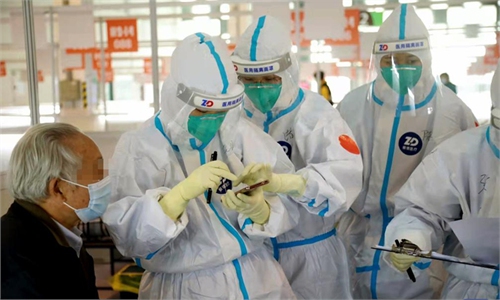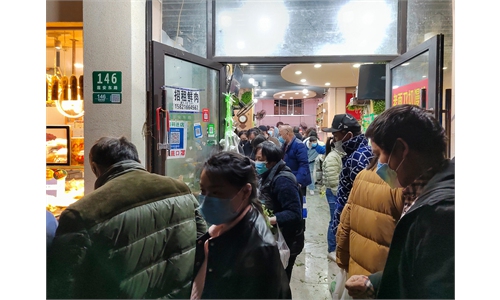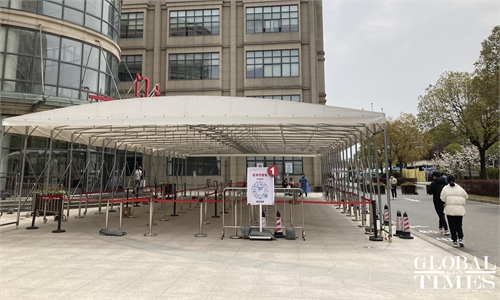China’s quest for new ways to handle Omicron
Timing of dynamic zero tolerance approach ‘crucial’
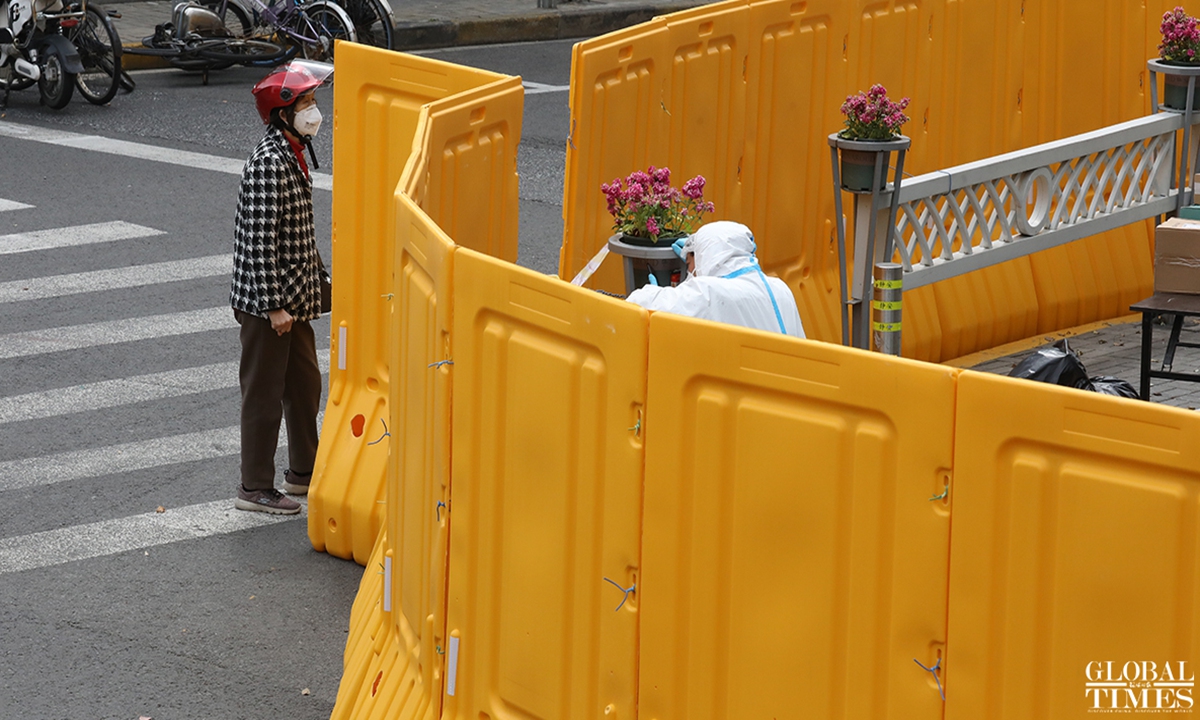
On Kangding road, Jing'an district of Shanghai, street barriers are placed to manage traffic outside the neighborhood communities. Some residents were jogging, while sanitation workers were busy collecting garbage.Photo: Hu Gong
As the highly transmissible Omicron variant continues to pose risks and concerns over the social and economic costs of the protracted epidemic grow, several major Chinese cities have embarked on a quest for an improved anti-epidemic approach that can both ensure dynamic zero-COVID targets and minimize disruptions to social and economic activities, with the latest approach of phased closed-off management - instead of citywide measures - imposed by Shanghai, the country's financial hub, starting on Monday.
Shanghai's move to divide the city into two parts and impose strict closed-off management in one part first is clearly aimed at minimizing social and economic disruptions, given the city's special status as a main economic, trade and financial hub in China. Shanghai's approach came one day after the tech hub of Shenzhen announced the resumption of normal life and work on Sunday after "hitting the slow button" to stem the spread of the COVID-19 for one week, when differentiated measures were taken in various parts of the city.
Meanwhile, Northeast China's Jilin Province, where strict prevention measures have been adopted, continued recording surging infection numbers, underscoring a series of loopholes seen in the city as it handles the latest outbreak.
The varying approaches of the country's dynamic zero-COVID strategy by the different cities underlined China's continuous efforts to improve the efficiency and reduce the costs of the anti-epidemic measures, even as many countries around the world have basically given up their efforts. With China's extensive successful experience and its relentless efforts for improvement, the country will be able to adjust its strategy to maximize results and minimize costs in combating the coronavirus, analysts said.
Shanghai carried out a staggered seal-off starting from Monday in Pudong and key areas of Puxi (divided by the Huangpu River) and mass nucleic acid tests will be conducted in the city covering over 6,340 square kilometers and with a population of over 24 million to cut hidden transmission routes in communities.
By carrying out China's dynamic zero policy, Shanghai had earlier implemented it in a precise way by allowing the majority of residents to maintain normal life and by targeting only a small part for mass screening for confirmed cases. Zhang Wenhong, one of the Shanghai-based prominent experts, also indicated that a long-term lockdown and seal-off management create trouble to people's daily lives that should be tackled.
When local officials explained why Shanghai can't be locked down, Wu Fan, an expert from the city's anti-epidemic leading expert team, highlighted the city's crucial role in the country's and world's economy. And by carrying out a combination of mass nucleic acid tests and antigen self-testing in key areas and non-key areas, local authorities ensured that many residents still could carry out a normal life, enjoy coffee time with their friends and ride bicycles during the weekend.
However, new ways have been introduced starting from Monday, as some loopholes have been exposed during the process of implementing precise anti-epidemic measures.
Wu told a press briefing on Monday that the current resurgence in COVID-19 cases in Shanghai is characterized by the coexistence of regional clusters and sporadic cases distributed across the city, and "it's necessary to conduct strict measures to reduce people flow and find the hidden transmission routes."
Did Shanghai fail in carrying out its precise dynamic zero approach and explore a new way for China to fight Omicron? Is the city re-adopting the strict lockdown and seal-off management measures like Shenzhen? How can Shanghai's experience help China deal with future COVID-19 flare-ups?
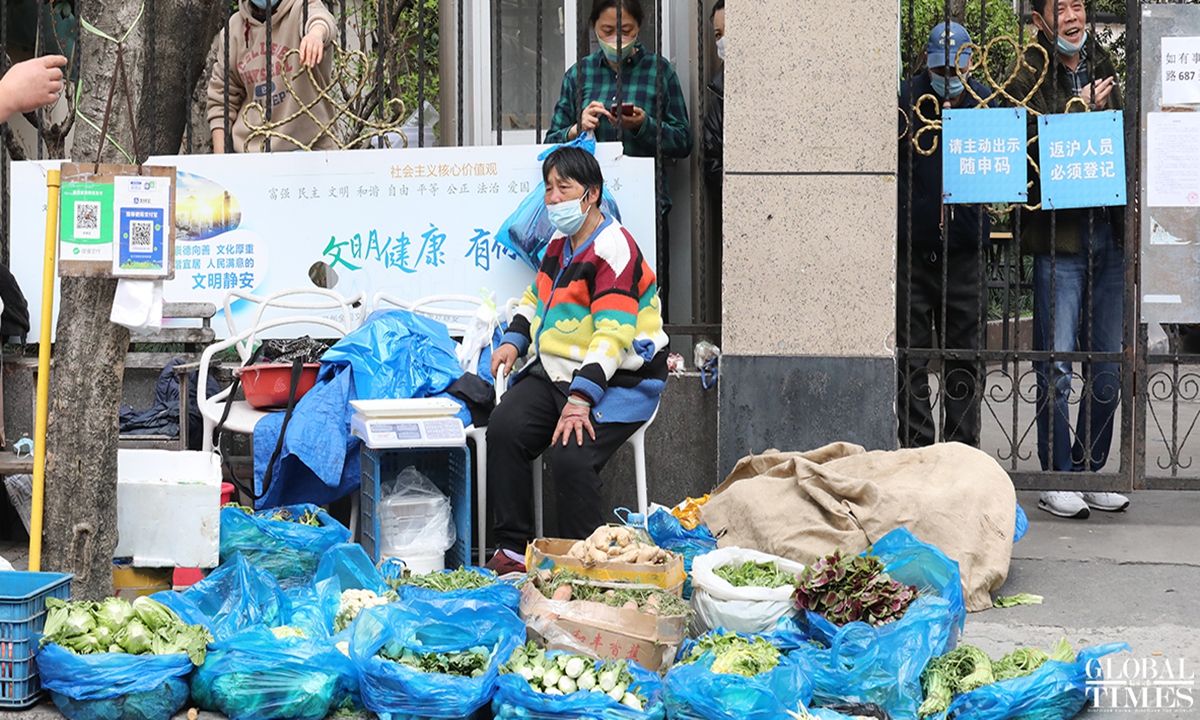
Shanghai residents were seen buying vegetables at Xikang Road grocery market in Jing'an District, Shanghai on Monday.Photo: Hu Gong
Exploring new ways
Some senior Chinese experts who closely follow the country's handling of the COVID-19 outbreaks over the past years consider Shanghai's exploration a courageous and necessary one, especially when more suggestions were made by epidemiologists in China and overseas to adjust China's zero tolerance strategy in a more dynamic way in lowering the costs on social development and people's livelihood, striking a balance between the regular anti-epidemic work and economic growth.
"There's no such thing as the best method," an expert close to China's CDC who preferred not to be named told the Global Times, noting that what matters is the proper timing for implementing the dynamic zero approach and fixing the loopholes.
"Considering the surge in daily infections, which could have spread to neighboring regions, Shanghai is adopting more strict measures, which does not mean its previous precise anti-epidemic work failed," Tao Lina, a Shanghai-based medical expert on vaccines, told the Global Times on Monday.
The proper timing of controlling the flare-up could be identifying infections earlier than the severe management loopholes exposed in the city's quarantine hotel Huating Hotel, and when there were fewer cases, the precise anti-epidemic measures could work in fending off the resurgence, Tao noted.
While the city could have responded more decisively to nip off earlier infections, it accumulated experiences for other cities including the fast mass screening by antigen self-testing, which helped handle the small-scale Omicron flare-up without heavily weighing on medical resources, experts said.
"To some extent, Shanghai conducted a necessary test," Zhuang Shilihe, a Guangzhou-based immunologist, told the Global Times on Monday. As the Omicron sub-variant BA.2 changes, there were secondary issues caused by the anti-epidemic measures.
As China's economic center, Shanghai had to strike a balance between economic and social development in anti-epidemic work, so it was necessary to think of a way to lower the cost and achieve the highest benefits, Chen Xi, an associated professor of public health at Yale University, told the Global Times on Monday.
Though there have been public debates in China about different anti-epidemic measures, cities across the country have been adopting different approaches, vastly different from the strict lockdown imposed at the early stage of the epidemic in Wuhan. Shenzhen has returned to normal after seven days of strict prevention and control measures that included placing all residential communities under closed management, suspending public transportation and closing stores and businesses, which was seen as much more efficient than previous city lockdowns in the early stages of the pandemic with the much lower social and economic cost.
Though many do not agree with an immediate reopening with the world considering the severe rampage of the COVID-19 overseas, almost no one would still prefer major lockdowns and strict measures until the virus is wiped out," Zhuang said.
Lessons accumulated
While experts agreed that both Shanghai and Shenzhen are accumulating the experiences for China's future handling of the COVID-19 outbreak as they fight the new flare-up, the country indeed has been adjusting its anti-epidemic strategy, for example, recently, by updating its COVID-19 playbook by placing COVID-19 patients with mild symptoms in centralized quarantine facilities instead of in hospitals, and lowering the bar for patients to be discharged from hospital.
Some Shanghai residents told the Global Times on Monday that although the city has been making efforts to contain the virus spread, some things still need to be fixed on a community level to ensure that the policy is effectively implemented.
For example, a 41-year-old resident surnamed Pan living in Meilong of Minhang district in Shanghai, where three COVID-19 medium-risk areas were classified so far, said the neighborhood committee workers have been working hard including organizing nucleic acid tests as they have been put under closed-loop management for 17 days.
"We are concerned if there will be more cases detected in our community. The related information should be announced in a timely manner to mitigate our concerns," Pan said.
Several residents in severely-hit Jilin Province told the Global Times there have been problems such as chaotic management in quarantine places as staff workers there have not been properly trained and the daily necessities are not being timely dispatched to each household.
"As it's also a long-term test for local officials and the health system, cities should learn from each other on how to be well-prepared in fighting the prolonged epidemic," Chen said, noting that being well-prepared psychologically is equally important.


